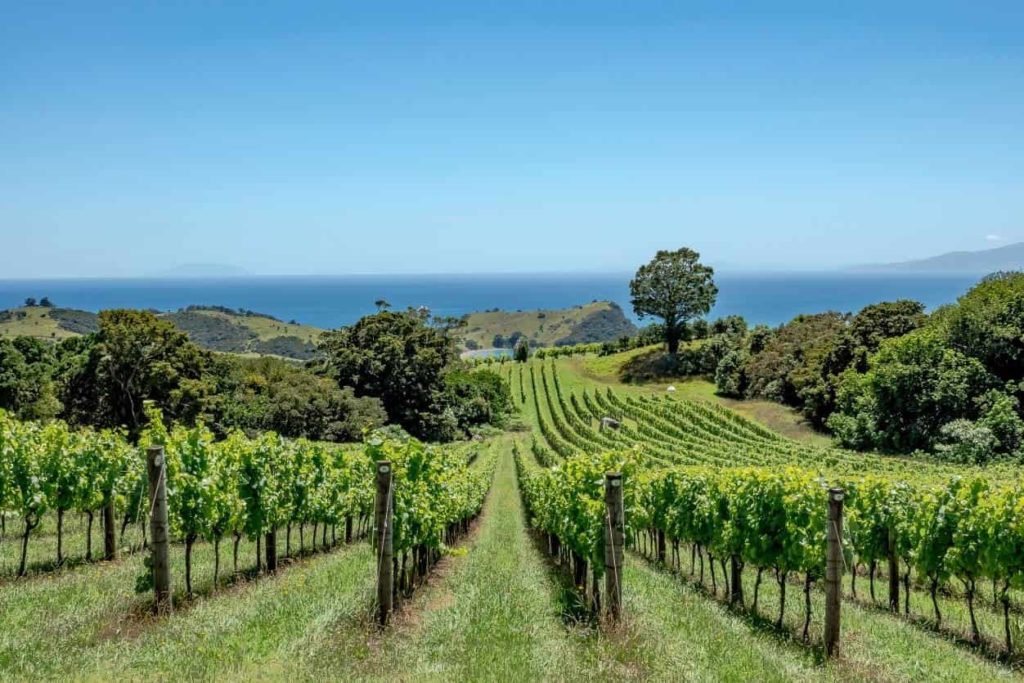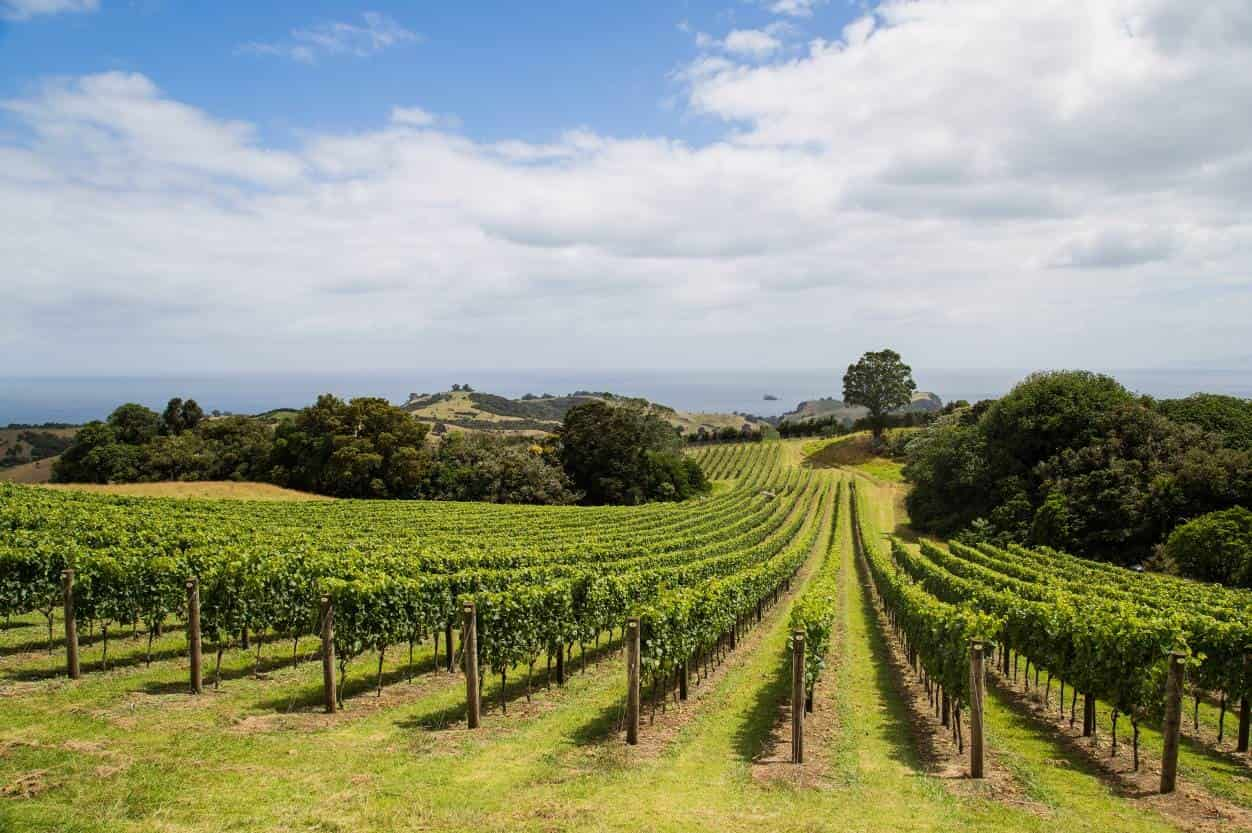
New Zealand wine guide: Auckland wine regions

Despite the widespread association with Marlborough Sauvignon Blanc, New Zealand presents a more complex picture. For example, the vineyards of Auckland on the North Island produce elegant Bordeaux blends, buttery Chardonnay, and apricot-scented Pinot Gris.
In fact, Auckland is one of New Zealand’s oldest wine regions. European immigrants in the early 1900s planted the first vines. The local tipple was derided as “Dally Plonk”, a reference to settlers from Croatia who arrived in New Zealand in the early 20th century. Despite the inclement subtropical climate, these pioneers recognised the potential of the region’s soils for viticulture. Today, progress in this part of the North Island continues – new producers, emerging terroirs, and a broader palette of grape varieties represent the contemporary face of New Zealand wine.
Click on a link to jump to that section:
Key wine regions of Auckland
Waiheke Island
This is arguably Auckland’s most important region, situated just 11 miles east of Auckland city. The first vines were not planted on this small island until the latter half of the 20th century. Nevertheless, over 25 New Zealand wineries produce exceptional wines of all three colours, including impressive sparkling wines. The region is best known for releasing small quantities of Bordeaux blends: these concoctions of Cabernet Sauvignon and Merlot are among the finest reds being made in New Zealand.
Producers in Waiheke Island are fortunate for several reasons. The island’s undulating landscape offers various elevations, soils and aspects that can be matched to a specific grape variety. In addition, the region’s climate is drier and warmer than the mainland, while cloud cover moderates the summer heat. Ocean breezes from the Hauraki Gulf also help to steady the ripening and balance alcohol and acidity. Planted on well-drained soils of weathered bedrock, the Auckland vines consistently yield small berries of highly concentrated fruit due to the nutrient-poor soil.
Kumeu
Kumeu wine country is one of Auckland’s leading sources of Burgundian-style Chardonnay and Pinot Noir. Dalmatian settlers from the Balkans founded the wine region. The appeal of winegrowing was impossible to resist, and by the 1940s, a flourishing wine industry was centred around the pretty town of Kumeu. This legacy continues into the 21st century as many wine producers are direct descendants of the first migrant families. Indeed, the Brajkoviches of Kumeu River continues to make some of the best New Zealand wine. In addition to world-class Chardonnay, Kumeu is also known for its voluptuous Merlot and aromatic Pinot Gris.
Vineyard sites are found northwest of Auckland, about 12 miles from the Pacific Ocean in the east. Like Waiheke Island, the climate is relatively temperate – oceanic influences help to moderate the summer heat, keeping acidity levels vibrant. Local soils are primarily based on clay and loam. Pinot Noir and Chardonnay enjoy similar conditions. As a result, Pinot Noir, Chardonnay and sparkling wine often come as a regional package.

Matakana
In the northern reaches of New Zealand, growers produce a small volume of exceptional red and white wines in the hills of Matakana. Winemakers here look beyond Sauvignon Blanc to Albariño, Sangiovese, and Dolcetto. The Albariño and Pinot Gris can be outstanding among white wine grape varieties. This is thanks to the region’s water-retentive clay soils, cooler nights, and bright sun. The Auckland Syrah is celebrated for its bright fruit and fresh acidity. Alternative varieties like Nebbiolo have also excelled in the region.
The climate here is subtropical, with noticeable humidity during the summer months. The warm sunny weather extends into autumn, and vine canopies benefit from the maritime breezes that blow off the Pacific and even the Tasman Sea, west Auckland.
Clevedon
Just south of Auckland is the up-and-coming wine district of Clevedon. Only surfacing 15 years ago, Clevedon is an excellent example of how much progress can be achieved in a short space of time. The vineyard sites are situated in the low-lying Whitford Hills and Hunua Ranges; small holdings are widespread here, and the average size of a Clevedon winery is less than five acres. Local producers grow red and white grapes in the area’s well-drained volcanic soils – the climate is warm and relatively dry in the summer months. As elsewhere, temperatures are also moderated by the oceanic breezes that travel west from the Pacific. The result is fresh and structured wines which offer bright, intense fruit. The Bordeaux blends of Puriri Hills are incredibly complex.

Key grape varieties
- Chardonnay – Burgundy’s signature white grape has developed a natural affinity with the vineyards of New Zealand. Kumeu produces consistently dazzling wines, although there is stiff competition from growers in Waiheke Island.
- Pinot Gris – New Zealand Pinot Gris is second to none: richly textured and very fresh. Top examples from Auckland offer a seductive palate of apricot, peach, citrus, and a delicate touch of lychee.
- Syrah – Auckland competes with Hawke’s Bay for the title of New Zealand’s finest Syrah region. Some can even stand up to wine from Northern Rhone, New Zealand Syrah can be magnificently fresh and vibrant, with ripe but persistent tannins and a long finish.
- Merlot – There is plenty of excellent Merlot being made in Auckland today. The grape, much-loved in the vineyards of Saint-Emilion and Pomerol, ripens earlier than Cabernet Sauvignon and is easier to grow. This variety thrives in the region of Clevedon.
Wine labels to try
Some of the wider region’s most iconic labels were founded less than 30 years ago. Puriri Hills, set up by Judy Fowler in 1997, is a testament to her incredible passion for the Bordeaux blends of the Right Bank: Merlot, Cabernet Sauvignon, Cabernet Franc, Carmenère, and Malbec .
Fowler’s nuanced winemaking benefits from the temperate climate of Clevedon. The low yields result in intensely aromatic red wines with complexity, depth and fine tannins. The top labels are kept at the winery for up to five years before release
Kumeu River has led the way in producing award-winning Chardonnay and Pinot Noir; the best examples can rival some Burgundy. Hunting Hill’s single-vineyard Chardonnay is one of the most vivid, powerfully structured and elegant white wines available from the region. The aromatic Pinot Noir and Pinot Gris are also excellent. Elsewhere, one of New Zealand’s most significant operations, Villa Maria, continues to market a range of affordable and well-made wines. Te Motu, Celia Hay, Kennedy Point, and Cable Bay are big names from the wine region.
Enjoying wine from Auckland
Few wine regions can satisfy gastronomes quite like Auckland. This corner of the North Island has a wine style and grape to suit every cuisine. They are characterised by direct flavours and mouthwatering acidity. Kumeu Chardonnay and Matakana Syrah are just two examples of innately food-friendly wines. Try confit de canard with Pinot Gris and scallops with Chardonnay. Enjoy a bottle of Puriri Hills with braised lamb shoulder – meat cooked until it is meltingly tender.
What to read next
An insider’s guide to white wine from the Loire Valley
An insider’s guide to wine from Northern Rhône
The big three grapes of Bordeaux wine




